by Maciej Gołąb [1]
Translated by Maksymilian Kapelański
Abstract
Controversies that still characterize the reception of the works of Józef Koffler, the most important Polish composer of the first half of the 20th century after Szymanowski, are the result of strong tensions between the different components of his musical aesthetics. From the diachronical point of view, the evolution of Koffler’s dynamic but unlimited style moved from interests in Polish music folklore and early European examples of serialism to attempting to implement the doctrine of social realism which was unprecedented in the Polish musical tradition.. Simultaneously, Koffler’s earlier folklorism was fused with experiences of the European avant-garde. Koffler’s dodecaphony incorporates neoclassical features of texture and form (of French as well as German provenance), and his last realizations of social realism are not deprived of individual artistic ambitions under conditions that radically reduced them of means of expression.
Article
1. “Polish Jewish Music:” A New or Old Historical Paradigm?
In the history twentieth-century music in Poland, Polish composers of Jewish origin belong to a generation whose members were born in the last decade of the nineteenth and the first decade of the twentieth century. Polish critics in the interwar period regarded them as spokesmen of radical avant-garde. Zdzislaw Jachimecki, a professor at the Jagellonian University, wrote in the 1930s:
In the group of composers made up of Rathaus, Tansman, Klecki, Gradstein, Jerzy Fitelberg and Koffler, very strong progressive tendencies have become manifest, issuing from the cross-influences of the Russian, German and French schools. With the exception of the last mentioned composer, all continuously live abroad, and-while emphasizing more or less decisively their belonging to Poland, either by their birthplace being in Poland, or in the sense of being Polish — their activity is connected more with other music cultures than with that of Poland. Nonetheless, they must be included within the perimeter of Polish contemporary music, since they are rightfully entitled to that, and are consistently included in Polish music by foreigners.[2]
Today, however, a different question comes to mind: is marking off this group of artists solely for the social and artistic reasons that guided Jachimecki valid, or does this group perhaps share a common stylistic-aesthetic experience? To help clarify this issue, I will discuss aspects of works by the following composers: Karol Rathaus (1895-1954), Józef Koffler (1896-1944), Alexander Tansman (1897-1986), Szymon Laks (1901-1983), Jerzy Fitelberg (1903-1951), Tadeusz Kassern (1904-1957), Alfred Gradstein (1904-1954) and Roman Palester (1907-1989).[3] It must be strongly stated that these composers participated in the turbulent aesthetic discourses of their time from a “European” perspective, rather than expressing particular artistic stances connected with their distinct cultural legacy. Accordingly, they partook in those characteristic transformations that were the experience of the European avant-garde of the 1920s-30s. They did not cultivate, on the other hand, either the conservative post-Moniuszko traditions (still alive in Poland between the wars), nor the modernist traditions of the Young Poland (the “Młoda Polska” group, which included Szymanowski and Ludomir Różycki). Some of them—Rathaus, Koffler, Tansman and Palester, for instance—appeared regularly on the musical scene of the International Society for Contemporary Music. Along with Szymanowski, they constituted a group of Polish representatives of new music that was recognized by international European critics. In contrast, pressure exerted on them by conservative criticism in Poland, especially in Warsaw, was massive.
Which stylistic and aesthetic aspects of these composers’ works should be accorded special attention? I believe that three key aspects may be singled out: first, the use of folkloric elements; second, neo-classicism; and finally, social realism. References to the folklore of Poland were especially popular among these composers in the earlier phases of their creative work. Examples include Tansman’s Album polski [Polish Album] (1916), Koffler’s 40 polskich pieśni ludowych [40 Polish Folksongs] (1925), and Palester’s Taniec z Osmołody[Dance from Osmołoda] (1933). However, it must be emphasized that pieces with Jewish subjects, such as Rapsodia hebrajska [Hebrew Rhapsody] (1937) by Tansman or Elegia żydowskich miasteczek [The Elegy of Jewish Towns] (1961) by Szymon Laks — who was a conductor of a band in Auschwitz — were rare. Twelve-tone serialism was used primarily by Koffler (starting as early as 1926), Rathaus (before World War II, in his Third String Quartet from 1936), and after the war also by Roman Palester (including his greatest work, Śmierć Don Juana [The Death of Don Juan] from 1959-61).
As for neo-classicism, the group’s choices for inspiration are characterized by an oscillation between French-Russian (Stravinsky) and German (Hindemith) sources. Starting as early as the mid-1920s, inspiration seems to be drawn from the French neo-classicism (in fact, many of these composers studied and were active in Paris). From the middle of the 1930s onward, the influence of German neo-classicism begins to predominate; changes in Koffler’s and Palester’s styles confirm this line of evolution with particular clarity.
In speaking about the chronologically latest stylistic and aesthetic aspect important to this group, i.e., social realism, I have in mind two composers who yielded to the pressure of cultural politics of the totalitarian system. One of them was Koffler, who in his last works abandoned the use of twelve-tone serialism — as, for example, in Uwertura radosna [Joyous Overture] (ca. 1940), written for the anniversary of the annexation of Lvov by the Red Army — and in his last piece returned to the idiom of his earlier folkloristic stereotypes (Ukrainski eskizy [Ukrainian Sketches], written before 1941). The other “socialist-realist” composer was Alfred Gradstein, who after the close of World War II, specialized in mass songs and panegyrical subjects (Kantata “Słowo o Stalinie” [Cantata “A Word on Stalin”], 1951).[4]
It will not be possible here to further discuss the differences in these composers’ realizations of stylistic models and the temporal shaping of their creative evolution. Rather, I will now focus on the assimilation of these stylistic impulses present in the compositional output of Józef Koffler, the “first Polish composer of twelve-tone music.”
2. The 1920s: Folkloristic Sources of Koffler’s Style
Józef Koffler (1896-1944), a Lvovian who in the course of his 48-year life was a citizen of Austro-Hungary, the Republic of Poland, German-occupied Poland and the Soviet Union, was a protoplast of twentieth-century avant-garde Polish music, and the kind of composer whose stylistic evolution takes a dynamic, yet not organic, course. From a diachronic point of view, it is sometimes difficult at times to note an organic link between works composed close together in time. From a synchronic point of view, even within the confines of one opus, there is a marked number of references and explorations — and these are found not only in the composer’s early pieces. In contrast to Schoenberg (whose work Koffler declared to be a point of reference), the continuity and organicism of evolution of a particular musical language do not strictly determine the changes in the configuration of elements that make up the Polish composer’s style. As a composer, Koffler was subject to an internal compulsion to react immediately to external artistic and intellectual inspiration. This instant, assimilative “reflex” is one of the basic traits of a “barometric” creative personality that was sensitive to all novelties. In other words, Koffler’s style spins out numerous changes and innovations, which do not always have an over-arching, constitutional impact on the style of a particular phase of compositional output.
This kind of change in style is apparent even in his first compositions. The years 1917-1927 can be deemed characteristic of the early phase of his style, but within this period it is difficult to find the “Ariadne’s thread” connecting the various attempts to achieve an original musical language. The few extant works of approximately the first decade of composing (most of the pieces were destroyed by the composer) include the eclectic, moderately modernist explorations of a tertium quid between the post-Wagnerian tradition and the impressionism of Debussy — see for example Zwei Lieder for soprano and piano, op. 1. In the next extant composition, Koffler refers to the national and folkloristic trend popular in European music of the 1920s. The miniatures that make up 40 polskich pieśni ludowych [40 Polish Folksongs], op. 6 testify to stylistic inconsistency; some reveal the influence of Rachmaninoff, others of Debussy and Ravel, while the most interesting ones are influenced by young Bartok and Prokofiev. Due to this disparate range of influences, the whole cycle oscillates between traditional major-minor harmonies, whole-tone modality, and a sharp, dissonant sonorities.[5]
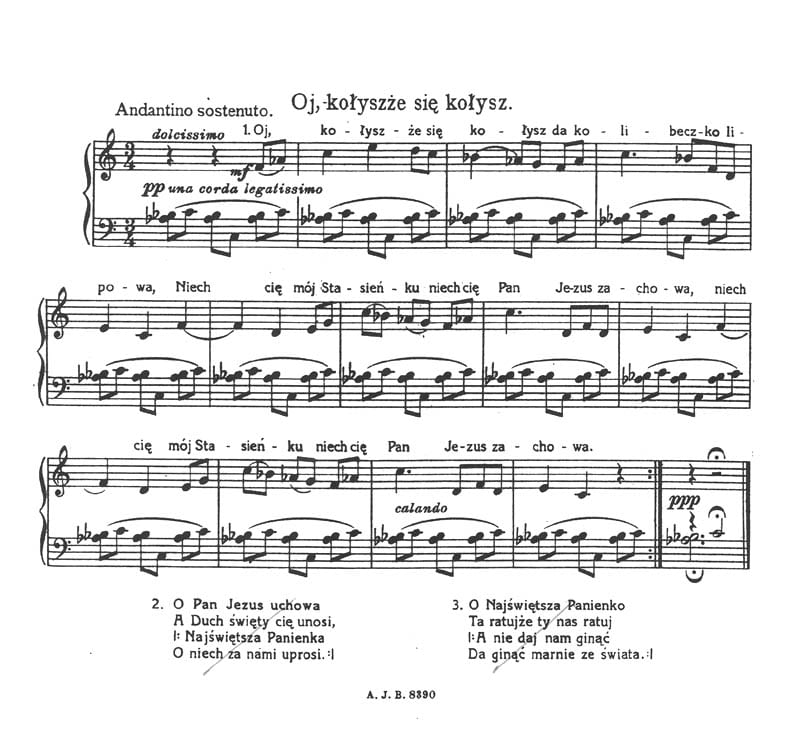
It is, finally, the three successive piano cycles that proved to be decisive in shaping Koffler’s style: Musique de ballet op. 7; Musique. Quasi una sonata op. 8, dedicated to Karol Szymanowski; and 15 Variations op. 9, dedicated to Schoenberg. Written in between 1926 and 1927, the cycles are witness to an early adoption of Schoenberg’s twelve-tone method (Koffler often cited this source of inspiration, though in his early compositions he seems to stand nearer to the aesthetics of “twelve-tone academism” of Joseph Matthias Hauer, Herbert Eimert or Fritz Heinrich Klein). [6] The cycles leave behind the sphere of national inspiration and folklore, and document a turn toward the aesthetics of neo-classicism, though understood in a still-simplified manner. In particular, the formal conventionality of these pieces, ossified by full twelve-tone textures, is offensive. Nevertheless, two fundamental categories shaped in these cycles, namely the transparent, classic texture, and the twelve-tone serialism on which it is based, become the basis of Koffler’s musical language up to 1940.
3. The 1930s: In the Sphere of Neo-Classical Inspirations
The determination of the end of the first period of creativity (i.e., up to 15 Variations, op. 9) is supported by considerations of an axiological nature. Up to the late 1920s, Koffler was not in full command of his compositional technique. A self-taught composer, he achieved his first success as late as 1931 at the festival of the International Society for Contemporary Music, thanks to the Streichtrio op. 10, published by Universal Edition. The second period of Koffler’s output (1928-1940) was marked by the same kind of dynamicism as found in European culture. The first phase of this period (to 1935) sees the creation of the most valuable portion of the Lvovian composer’s musical output. From 1935 onward, a weakening in the dynamics of his explorations can be clearly perceived. This weakening is in direct relation to political factors, such as the mounting Fascist mood and growing wave of anti-Semitism in Europe. Facts such as the dismissal of Schoenberg from the Berlin Academy, the “Entartete Musik” [“Degenerate Music”] exhibition in Dusseldorf, and the numerous publications of the “Judentum und Musik” type could not have escaped the attention of Koffler. In general, the adoption of serial dodecaphony as a basis for the organization of sounds as well as the firm establishment of neo-classical aesthetics were the distinguishing features of Koffler’s music in this period. The first characteristic is confirmed in his own writings which describe his compositional technique. In contrast, there are no texts about neo-classicism; the composer only makes reference to the aesthetics of Schoenberg and Berg.
What forms does Koffler’s neo-classicism assume, and to what models does he refer? First of all, we must draw attention to a clear line of evolution in his twelve-tone technique. Historically, the year 1926 (in which Koffler completes his first twelve-tone composition, Musique de ballet for piano, op. 7), places him within the core group of European pioneers in serial technique, next to Schoenberg, Berg, Weber, Hauer, Klein and Eimert, as well as composers of the Russian avant-garde such as Nikolai Roslavec, Jefim Golyscheff or Nikolai Obuchov. In contrast to the composers from this list who do not belong to the Second Viennese School, Koffler made a quick departure from the encumbering twelve-tone speculations typical of “twelve -tone academism”. Moreover, during the early phase of his work on his first twelve-tone compositions, Koffler conducted technical experiments which appear slightly later in the music produced by the Second Viennese School. Among these experiments we should cite a method of cyclic permutation of the series, which appears in Koffler’s op. 8 [1927] — earlier than Alban Berg’s Violin Concerto from 1935.[7]
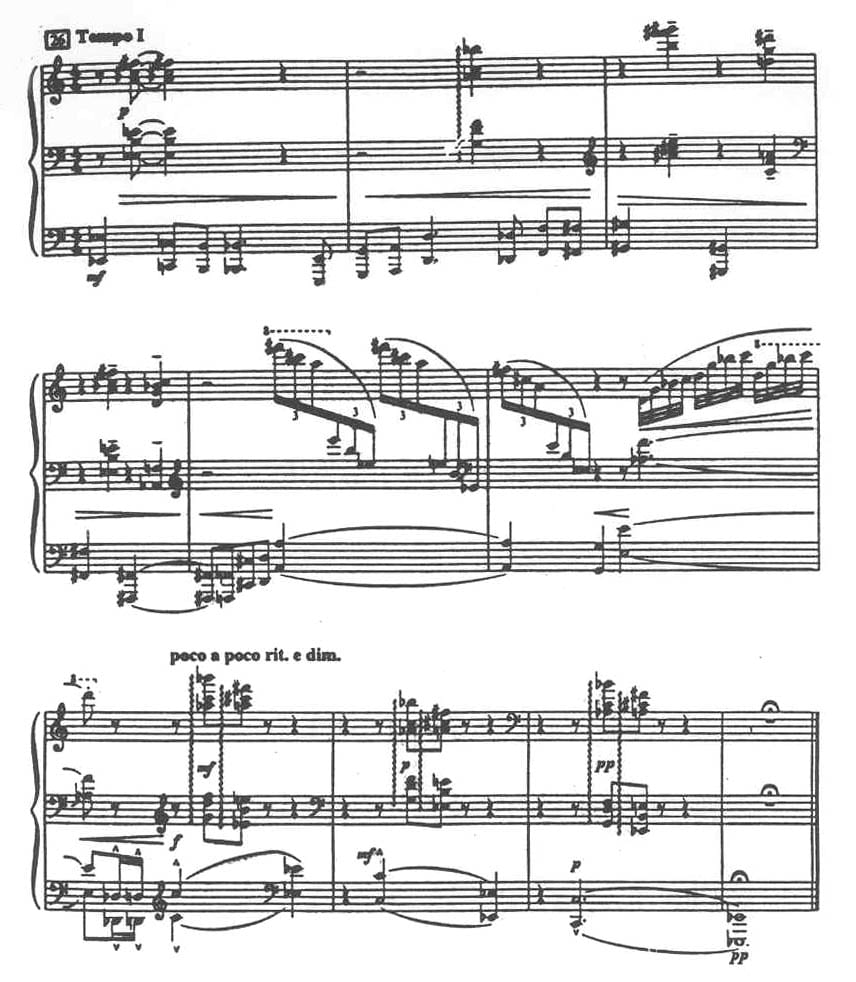

This compositional tool is combined at times with an elaborate system of axial and concentric symmetries. In opp. 7-9, Koffler experimented with the relations between musical syntax and serial syntax, placing musical narration in strict subordination to schematic matrices of serial syntax. The results that he achieved on the technical and formal plane in the group of early twelve-tone compositions are not found in pieces by Schoenberg, where both syntaxes manifest a far-reaching autonomy (Third String Quartet, op. 30, 1927).[8]
However, beginning with the Streichtrio, op. 10 (1928) Koffler ceases to idolize the twelve-tone series and reduces the means of this compositional technique, being content with as little as a simple thematic serialism. Artistic questions become more important than “technical tricks.” In this sort of approach to twelve-tone technique, Koffler is closest to Schoenberg, who — as is known — emphasized the importance of the aesthetic aspect in twelve-tone composition. Nevertheless, in some works from the mid-1930s, Koffler stepped onto the experimental track once more. He dreamed of solving the Bergian theorem of a synthesis of the dodecaphonic system with the tonal system. Unfortunately, the attempt proved to be futile.
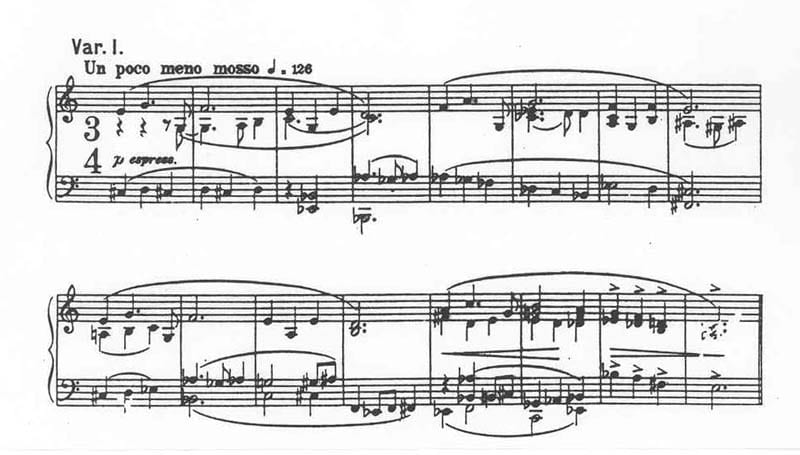
The Kofflerian synthesis of the tonal subject of the “Emperor Waltz” by Johann Strauss with a consistently atonal accompaniment constitutes a proposition that is too primitive to match such masterpieces as Berg’s Violin Concerto or aria Der Wein (cf. Koffler’s Variations sur une valse de Johann Strauss, op. 23). Nevertheless, Koffler was among the few composers in the 1930s who attempted to solve the difficult paradox of a synthesis of both systems of pitch organization. In general, the use of twelve-tone serialism places Koffler among the European pioneers of this compositional technique.
Koffler’s experiments were not limited to twelve-tone serialism; they also encompassed instrumental texture. His First and Second Symphonies are very interesting works with regard to the issue of Koffler’s reception of the ideals developed by the Second Viennese School. Both works reconfigure those stylistic qualities, which — though derived from Schoenberg’s ideas — assumed an alternative guise in the music of the Lvovian composer. Koffler’s First Symphony, op. 11 (1930) most closely approaches Schoenberg’s own scores. In the scoring and notation of this twelve-tone work, Koffler’s interest in Klangfarbenmelodie seems to come through more strongly than in any other of his works. The scoring is exceedingly “disproportionate.”
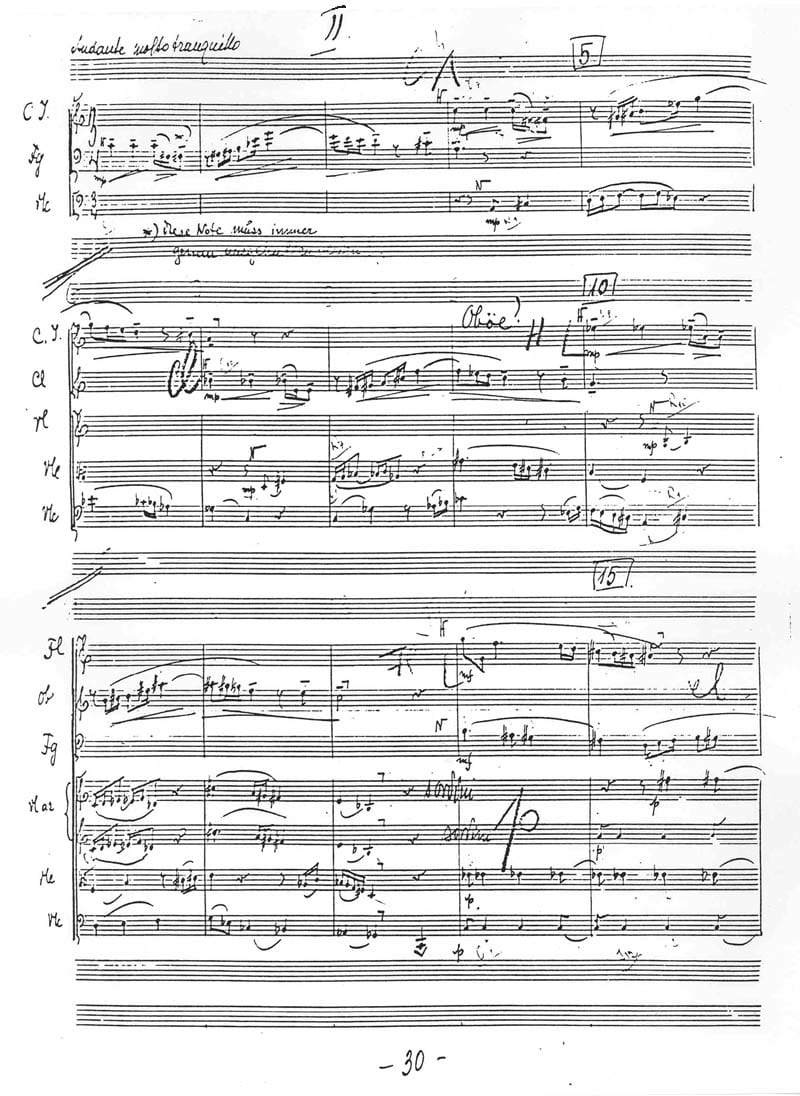
Apart from the string quartet and a modest group of brass instruments, attention is drawn to an expanded group of woodwinds and percussion that have a timbral function (among others, there is a keyboard Glockenspiel, xylophone, vibraphone, celesta, harp, guitar and mandolins). Conspicuous aspects of this piece include: the constantly applied principle of limiting the use of chromatic signs only to the notes where they appear, and especially the practice of indicating the hierarchy of voices by using graphic symbols. This system, which distinguishes between main voices (H – Hauptstimme) and secondary ones (N – Nebenstimme), was first introduced by Schoenberg and served to simplify the conductor’s task of identifying the hierarchy of orchestral parts. These traits leave no doubt that Koffler had an excellent knowledge of Schoenberg’s scores from the expressionist period and that he transferred those traits to his own twelve-tone scores at a time when Schoenberg and his students were turning their interests toward the reduced and more homogeneous classical orchestra.
Equally striking is the beginning of Koffler’s Third Symphony, his best one, where he performs a synthesis — not typical of Schoenberg and his students — of the “twelve-tone sonority” (i.e., of the relatively homogeneous patterns of timbres totally controlled by the pitch patterns) with an orchestration technique derived from Klangfarbenmelodie.
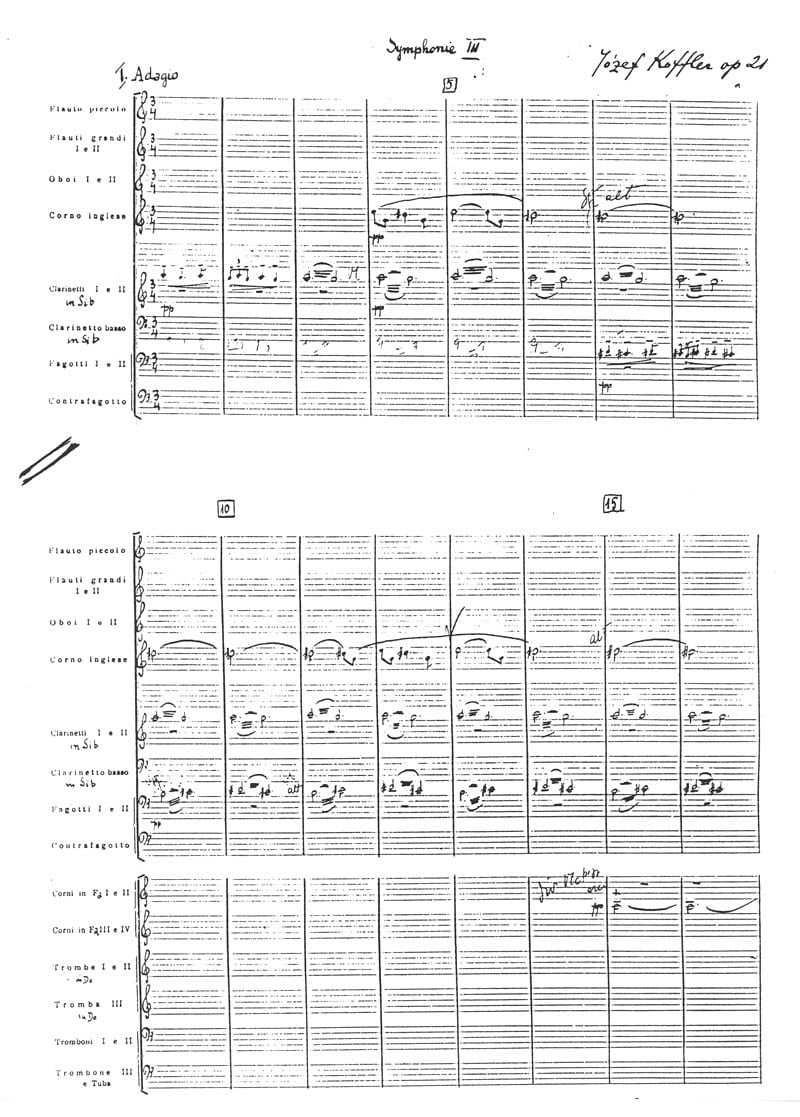
The “Adagio” that introduces the Symphony consciously references the Beethovenian concept of the “birth” of a subject from a single note (for example, at the beginning of the Ninth Symphony), yet the way the texture is built seems more closely related to Schoenberg’s “Farben” from the cycle of Fünf Orchesterstücke, op. 16 (1909), and even more so to the third piece from Webern’s cycle of the same title, op. 10 (1913). Koffler adopts Webern’s concept of a static “background” of sonority (Webern’s is more heterogeneous, while Koffler’s is more massive and subject to fusion), against which micromotivic figures stand out. Nevertheless, in Koffler’s work, this “sonorous plasma” creates a twelve-tone aggregate controlled by the norms of twelve-tone serialism. Thus, a new quality is produced as the composer manages to reconcile powerful sonic transformations with serial dodecaphony-ideas that were mutually exclusive in the Second Viennese School.[9]
The mature period of Koffler’s compositional output, approaching neo-classicism in general, does not stabilize the stylistic idiom either in the diachronic or synchronic sense. The inconsistency in choosing compositional means is very clear, the means having been drawn by the composer from two distinct branches of European neo-classicism of the 1920s-30s: French-Russian and German-Austrian. As is known, the traits characteristic of the French-Russian orientation are: the existence of defined stylistic models, relative simplicity of texture and form, use of the quasi-collage principle, lack of polyphony and the employment of a secco type of sonority. The German-Austrian orientation is characterized by genre models existing as historically-generalized norms, a “process” principle of development, the use of polyphony and a sonically transformed type of sound. Using these criteria, it is possible to discriminate between the first orientation (parodistic), with roots in the ballets of Igor Stravinsky, and the second (sonoristic), which stems largely from the “Neue Sachlichkeit” of Paul Hindemith. [10]
I am reminding readers of the difference between these two styles — well-known today — to show that from a diachronic point of view, a fascination with the French type of neo-classicism prevails in Koffler’s music from the first half of the 1930s, while in his last works of this period, the German type comes to the fore. The parodistic quality of some of the works from the earlier phase is clearly evident in Sonatina, op. 12, where Koffler (following in the steps of many other composers) makes reference to the sonata of Clementi. Upon discovering and identifying Koffler’s Piano Concerto, op. 13, I found that the first movement was based on the formal outline of Schumann’s Toccata op. 7, the second movement on the Fieldean nocturne, and the third on the Chopin Rondo ŕ la Krakowiak.
In the Second Symphony, op. 17, the composer makes reference to the Viennese Classical symphonies. However, in the Fourth Symphony, op. 26 (his last one), no dialogue with a “specified” musical tradition is to be found. The premise of neo-classicism as a “generalized” dialogue with tradition was discernable even earlier, for example in the Streichtrio, op. 10 and particularly in the cantata Die Liebe, op. 14. Also, the ballet Alles durch M.O.W., op. 15 is a direct reference to the “chronicles of the day” (such as newspaper columns) that were popular at the time (these were also the undisguised inspiration for Neues vom Tage by Hindemith and Schoenberg’s Von heute auf Morgen). During this period, then, stylistic changes indicate an indecisive shift of weight.
To a certain extent, this lack of stylistic homogeneity is also clear in the synchronic sense. As a rule, Koffler’s allegros set up a thematic dualism which deliberately contrasts the first subject (secco type) with a second subject; this second subject is sonoristically transformed to a great extent, often through the use of polyphony. Nor does the work as a whole give an impression of stylistic incoherence since this technique increases thematic contrast, which is the norm of the genre. Koffler’s last large work, the Fourth Symphony, op. 26, shows that — if not for historical circumstances — this probably would have been the direction of his unrealized compositional projects. The European avant-garde lost its impetus in the course of suppression under two totalitarian regimes, which also resulted in the weakening of Koffler’s creative dynamicism. Apart from the Fourth Symphony, Koffler makes only orchestral arrangements of other composer’s pieces at this time: e.g., Suita polska [Polish Suite], op. 24 (from Polish folk music); Mała Suita wg. J.S. Bacha [The Little Suite According to J.S. Bach] (dances from the books of Anna Magdalena Bach), and the marvelous transcription of Bach’s Goldberg Variationen for small orchestra, commissioned by Hermann Scherchen.
4. The 1940s: Social Realism — the Final Change in Style
The last change in Koffler’s compositional style (1940-1941) unfolded under the pressure of Soviet cultural politics after the invasion of the Western Ukraine by the Red Army. Closely watched by the critics and authorities of the Association of Soviet Composers (SSK), Koffler first tried to secure concessions from these authorities by using the ideologically correct program of the Joyous! Overture, op. 25, as “ransom material”, writing the piece to commemorate the anniversary of the Red Army’s march into Lvov. Koffler’s public self-criticism and his acceptance of academic entitlements from the Soviets, did not, however, divert the attention of authorities from the composer’s “formalist” aesthetics, and in his last two pieces (Czotyry dytjaczi piesy [4 Pieces for Children] and Ukrainski eskizy [Ukrainian Sketches], op. 27) the composer made reference to the spirit of his early compositions, especially 40 polskich piesni ludowych, op. 6 [40 Polish Folksongs].
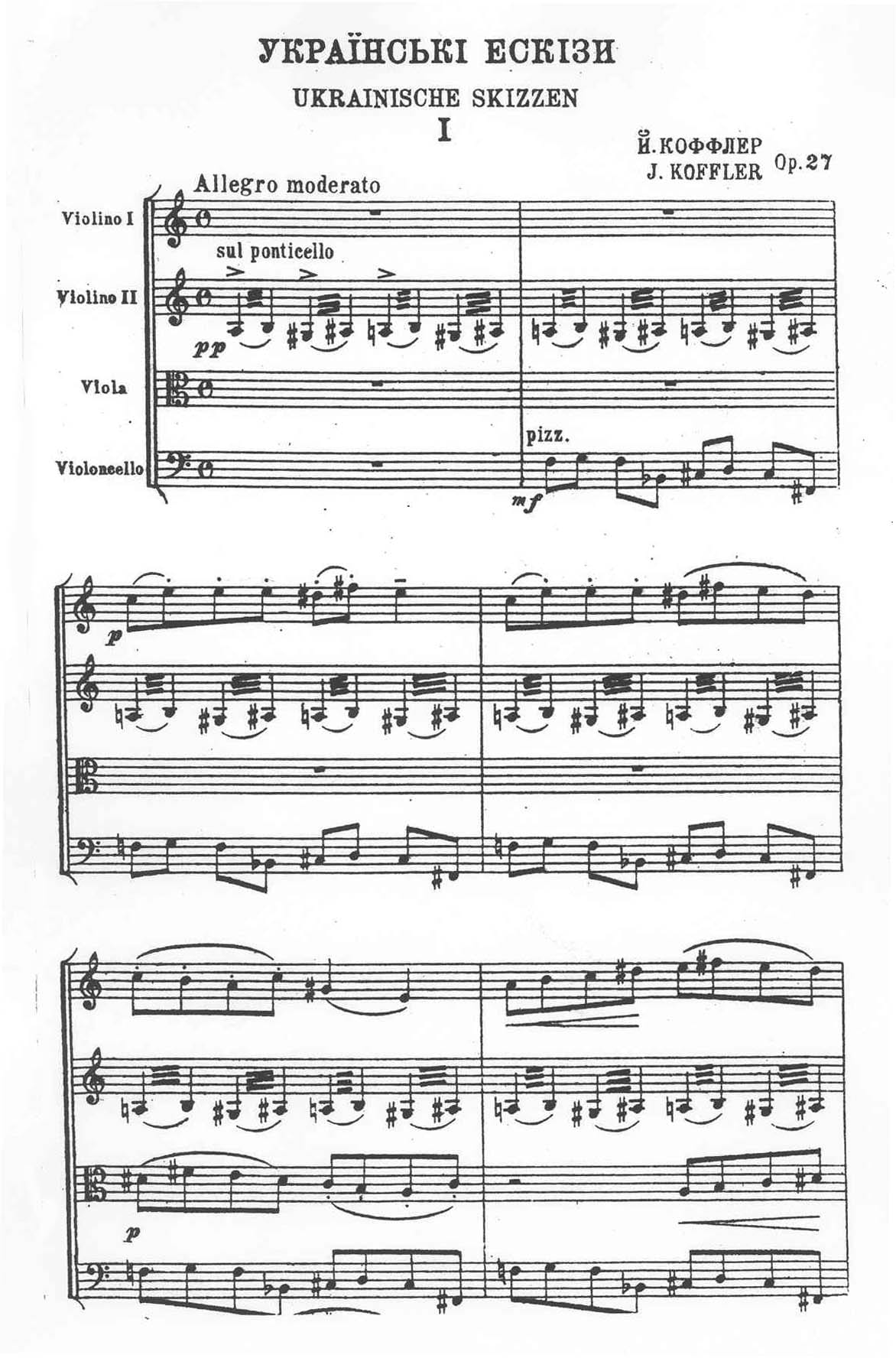
Each of the six pieces that make up the Ukrainian Sketches, well-suited to the slogans of social realism though not devoid of elegance, contain arrangements of well-known Ukrainian folk melodies (among others kolomyjka and kozaczek). The re-enacted vision of Koffler’s early use of folkloristic elements turned out to be only an anachronism in his compositional style at the threshold of the forties. Essentially, Koffler’s social realism did not reveal any new stylistic qualities, and it was marked by a strongly regressive tendency with roots in Koffler’s early folkloristic experience.
5. Concluding Remarks: The Significance of Koffler’s Compositional Output
Looking at the output of Polish composers from the point of view of twentieth-century European music, Koffler’s music — as I have tried to point out — was, first of all, tied in manifold ways to the ideas of the European avant-garde, though his music was not purely cosmopolitan. For the historian concerned with classification, Koffler’s frequent, typically Polish intonations of a patriotic, folkloristic or religious character may furnish as good a means of establishing his place within the heritage of Polish music as his pedagogic, critical and literary activity during his time at the Lvov Conservatory of the Polish Music Society. I believe, however, that this kind of thinking oversimplifies the problem. These characteristics of his musical aesthetics do not constitute the decisive criteria for evaluating Koffler’s essential place in the heritage of contemporary Polish music. Folkloristic music is only an outward, superficial manifestation of culture, which remains as such in Koffler’s music.
Paradoxically, the case of Koffler and his significance for the Polish musical heritage should not be regarded in a national context, but rather in the more universal context of European avant-garde ideas from the first half of the twentieth century (a key context for this composer). Koffler’s case reminds us of the most vital dilemmas of the Polish musical heritage, of problems of identity and the pursuit of universality. The composer was extremely lonely his entire life, incessantly haunted by Polish conservative criticism, doomed to a lack of understanding in his own country, openly “anti-Polish” in the Soviet period of his life, and later murdered — together with his entire family — by the Nazis. Through his dramatic example, he was the first to show the perspectives as well as the futilities of contemporary music for those Polish composers who would step into the “Darmstadt-Warsaw” arena a dozen years or so after his death. Embroiled in the turbulent aesthetic discourses of his time, he will surely long remain a key to, as well as a controversial figure in, the historiography of Polish twentieth-century music.
One final paradox I should like to point out has to do with the fact that while Koffler’s music in its mature phase draws upon the achievements of the avant-garde from the 1920s and 30s, it does not become one of the many examples in Polish musical culture of a simple and direct transmission of patterns shaped in one of the dominant European cultural centers. His musical output is not an adaptation of one complete set of stylistic categories. In addition, while he refers to the heritage of the Second Viennese School, the composer also creates mutations and metamorphoses, transformations and reconfigurations of models not extant in the original context of style and system. In this sense, Koffler is undoubtedly one of the first composers to transform the heritage of the Second Viennese School and Euclassicismo-classcism into a living cultural legacy, creating a bridge between the European avant-garde of the 1920s and 30s on the one hand, and the avant-garde of the 1950s and 60s on the other.
Notes
[1]. This paper provides a survey of topics discussed in-depth in Prof. Gołąb’s monograph on Józef Koffler published in Polish by Musica Iagellonica in 1995. English translation of this important study, by Maksymilian Kapelański, Marek Żebrowski and Linda Schubert, with a foreword of Prof. Antony Polonsky, Chair of Holocaust Studies at Brandeis University, will appear in 2003 as No. 8 in the Polish Music History Series published by PMC. [Ed.]. [Back]
[2]. Zdzislaw Jachimecki, “Muzyka polska 1896-1930” [Polish Music 1896-1930] in Polska. jej dzieje i kultura [Poland. its History and Culture], Vol. III (Warsaw: n.p., n.d.), 934-935.[Back]
[3]. The state of research on the output of this group is, unfortunately, very modest. If we do not count the old and outdated book on Tansman by Irving Schwerke (Alexandre Tansman, compositeur polonais. Paris, 1931), only the life and work of Józef Koffler has been accorded a monograph study, in which the analysis of works coincide with the documentation of life and compositional output as well as an attempt at an historical and aesthetic evaluation (cf. Maciej Golab: Józef Koffler (Cracow: n.p., 1995). A book on Roman Palester is being prepared for publication by Zofia Helman.(Anna Granat Janki published a monograph on Tansman in 1997; Helman’s Roman Palester was published by Musica Iagellonica in 2002.- Ed.) [Back]
[4]. Equally lacking is a broad, monograph study of the social-realist period in the musical culture of Poland between 1949 and 1956. The subject is undoubtedly one of the most pressing tasks of Polish twentieth-century music historiography. [In 2000 Prof. Adrian Thomas was awarded a two-year Arts and Humanities Research Board grant for work on post-war socialist realism in Polish music. The results of this project so far include an international conference “Socialist Realism in Central European Music: 1945-1955” held at Cardiff University, UK, in March 2001. -Ed.] [Back]
[5]. Issues concerning the genesis of Koffler’s works are more fully discussed in my book Józef Koff1er, op. cit., 15-50, as well as in the article “Des Schaff en Józef Kofflers Probleme einer Stilgestaltung” in Verfemte Musik. Komponisten in der Diktaturen unseres Jahrhunderts, ed. Joachim Braun, Vladimir Karbusicky and Heidi Tamar Hoffmann (Frankfurt am Main: Verlag Peter Lang, 1995), 205-217 and 447-452. [Back]
[6]. In my article “Zwölftontechnik bei Jozef Koffler. Ein polnisher Beitrag zur Geschichte der Dodekaphonie in der ersten Halfte des 20. Jahrhunderts,” Musik des Ostens, Bd. 10 (1986): 167-179, I consider the problem of how much Koffler, when adopting twelve-tone serialism, could have been inspired by not only the early twelve-tone compositions of Schoenberg (which he often mentions in his writings), but also by the theoretical writings and compositions of Josef Matthias Hauer, since traces of some norms of Hauer’s theory of tropes are present in Koffler’s early twelve-tone opuses. [Back]
[7]. Douglas Jarman, The Music of Alban Berg (University of California Press: 1985), 80. [Back]
[8]. On the subject of Koffler’s twelve-tone serialism, see especially Iwona Linstedt’s “Dodekafonia w symfoniach Józefa Kofflera,” [“Twelve-tone serialism in the symphonies of Józef Koffler”], Muzyka 2 (1996): 17-73. A valuable contribution of this author to research on new music in Poland is her doctoral dissertation recently completed under my guidance: Dodekafonia i serializm w twórczości kompozytorów polskich XX wieku [Twelve-Note Serialism and Total Serialism in the Works of Twentieth-Century Polish Composers], (Ph.D. diss., University of Warsaw, Institute of Musicology, 1998). [Back]
[9]. Koffler’s ties with the Viennese School are more fully discussed in my article “Józef Koffler i Szkoła Wiedeńska” [Józef Koffler and the Viennese School], Muzyka, no. 2 (1996): 3-16. [Back]
[10]. The opposition of the parodistic and sonoristic types of neo-classicism constitutes one of the fundamental axes of Maria Piotrowska’s work Neoklasycyzm w muzyce XX wieku[Neo-classicism in Twentieth-Century Music] (Warsaw: n.p, 1982), 61-99. [Back]
Józef Koffler Bibliography and List of Works
by Maciej Gołąb
Selected Bibliography
- Folga, Zygmunt. “Dodekafonia Józefa Koffiera” [Józef Koffler’s Twelve-Tone Serialism]. Muzyka 4 (1972): 65-83.
- Freiheiter, Jerzy. “Józef Koffler.” Muzyka 7-8 (1936): 85-86. cj.
- Gołąb, Maciej. “Zwolftontechnik bei Józef Koffier. Ein polnisher Beitrag zur Geschichte der Dodekaphonie in der ersten H lfte des 20. Jahrhunderts.” Musik des ‘Ostens. 10 (1986): 167-179.
- Gołąb, Maciej. Dodekafonia. Studia nod teorią i kompozycją I polowy XX wieku [Twelve- Tone Serialism. Studies of the Theory and Composition of the First Half of the Twentieth Century]. Bydgoszcz, 1987.
- Gołąb, Maciej. “Das Schaff en Jozef Koffiers -Probleme einer Stilgestaltung.” Verfemte Musik. Komponisten in den Diktaturen unseres Jahrhunderts. Ed. J. Braun, V. Karbusicky, H.T. Hoffmann. Frankfurt am Main, 1995, pp. 205-217.
- Gołąb, Maciej. Józef Koffler. Kraków: Musica Iagellonica, 1995. English translation by Maksymilian Kapelański, Marek Üebrowski and Linda Schubert forthcoming, Los Angeles: Polish Music Center, 2003.
- Gołąb, Maciej. “Józef Koffler i Szkoła Wiedeńska” [Józef Koffler and the Viennese School]. Muzyka 2 (1996): 3-16.
- Linstedt, Iwona. “Dodekafonia w symfoniach Jozefa Kofflera” [Twelve-tone serialism in the symphonies of Jozef Koffler]. Muzyka 2 (1996): 17-74.
- Lindstedt, Iwona “Instrumentacja a forma w symfoniach Jozefa Koffiera” [Instrumentation and Form in the Symphonies of Józef Koffler]. Muzyka 2 (1996): 75-130.
- Mazepa, Leszek. “Okres radziecki w życiu i twórczości Józefa Kofflera” [The Soviet Period in the Life and Works of Józef Koffler]. Muzyka 1 (1983): 67-100.
- Mazepa, Leszek. “Relacje prasy lwowskiej o wykonaniach utworow Józefa Kofflera” [The Press of Lvov on the Performances of Józef Koffler’s Compositions]. Muzyka 2 (1996): 139-158.
- Muzyka 2 (1996). Special issue devoted to Koffler.
- Zduniak, Maria. “Twórczość i działalność Józefa Kofflera w okresie 20-lecia międzywojennego” [The Music and Activity of Józef Koffier in the Interwar Period]. Zeszyty naukowe Akademii Muzycznej we Wrocławiu. 33 (Wrocław, 1983): 37-59.
Selected Works by Józef Koffler
For the Stage
- Op. 15. Alles durch M.O.W.: Ballet; solo soprano, solo baritone, chorus, orch., 1932.
Orchestral Music
- Op. 9a. 15 Wariacyj szeregu 12 tonówo. [15 Variations on a Twelve-Tone Series] for strings; [based on op. 9, 1927], 1931 (Senart, 1933).
- Op. 11. Symphony no. 1. 3 mov’ts; chamber orch., 1930.
- Op. 13. Piano concerto. 3 mov’ts, 1932.
- Op. 17. Symphony No.2. 4 mov’ts, 1933.
- Op. 21. Symphony No.3. Four mov’ts; winds, harp, percussion; about 1935.
- Op. 24. Suita polska. [Polish Suite], Chamber orch.; 1936 (lost).
- Op. 25. Uwertura radosna. [Joyous Overture], 1940 (lost).
- Op. 26. Symphony No.4. 4 mov’ts, 1940.
- Handeliana. 30 Wariacji na temat passacaglii Handla. [Haendeliana. 30 Variations on Handel’s Passacaglia Theme], about 1940 (lost).
Chamber Music
- IOp. 10. String Trio. 1928 (Universal Edition, 1929).
- Op. 16. Divertimento. Oboe, cl, basoon, 1931 (lost).
- Op. 18. Capriccio. Vn, pf, about 1936.
- Op. 20. String Quartet. 1934 (lost).
- Op. 27. Ukrainski eskizy. [Ukrainian Sketches] for string quartet, composed before 1941 (Mystectwo, 1941).
Piano Music
- Chanson Slave. Before 1918 (A. de Smit, 1925). Op. 6. 40 Polskich piesni ludowych. [40 Polish Folksongs], 1925 (Benjamin, 1926).
- Op. 7. Musique de ballet. 1926 (Senart, 1927).
- Op. 8. Musique. Quasi una sonata. 1927 (Senart, 1928).
- Op. 9. 15 Wariacyj szeregu 12 tonów. [15 Variations on a Twelve-Tone Series], 1927 (Senart, 1928).
- Op. 12. Sonatine. 1930 (Universal Edition, 1931).
- Op. 19. Sonata. 1935 (lost).
- Op. 23. 20 Variations sur une valse de Johann Strauss. 1935 (Universal Edition,1936).
- Czotyry dytjaczi piesy. [4 Pieces for Children], before 1940 (Mystectwo, 1940).
Vocal Music
- Op. 1. Zwei Lieder. Solo soprano, pf, 1917.
- Op. 14. Die Liebe [Love]. (Paul’s First Letter to the Corinthians). Cantata; vn, cl, vIa, vlc, 1931 (Universal Edition, 1932).
- Op. 22. 4 poemes. (A. de Musset, P. Verlaine, A.V. Amault), 1 vn, pf, 1935 (Senart, 1935).
Orchestrations
- J.S. Bach: Little Suite. About 1937 (lost).
- J.S. Bach: Goldberg-Variationen. About 1938.
Prof. dr. hab. Maciej Gołąb studied musicology at the University of Warsaw with Prof. Józef Chomiński (music history) and Prof. Zofia Lissa (music theory and aesthetics). Since 1978 he is a faculty member of the Institute of Musicology, University of Warsaw, now serving in the rank of Professor (between 1991 and 1996 he was Deputy Director of the Institute). Prof Gołąb specializes in Polish music of the 19th and the 20th centuries, especially Chopin, Webern and 12-tone music. He is the author of five books: Dodecaphony. Studies in the Theory and Composition of the First Half of the 20th Century (Bydgoszcz 1987; this study is based on his doctoral dissertation), Chromaticism and Tonality in Chopin’s Music (Kraków 1991; the monograph has also appeared in German), Transformational Changes in Chopin’s Style (Krakow 1993; an edited volume of studies), Józef Koffler (Kraków: Musica Iagellonica, 1995; English version forthcoming from the Polish Music Center, 2003), and Spór o granice poznania dzieła muzycznego [Dispute about the Limits of Knowledge of the Musical Work] (Wrocław, 2002). Maciej Gołąb is a professor at the Universities of Warsaw and Wrocław. For a decade served as the General Editor of the Polish Musicological Quarterly, Muzyka.